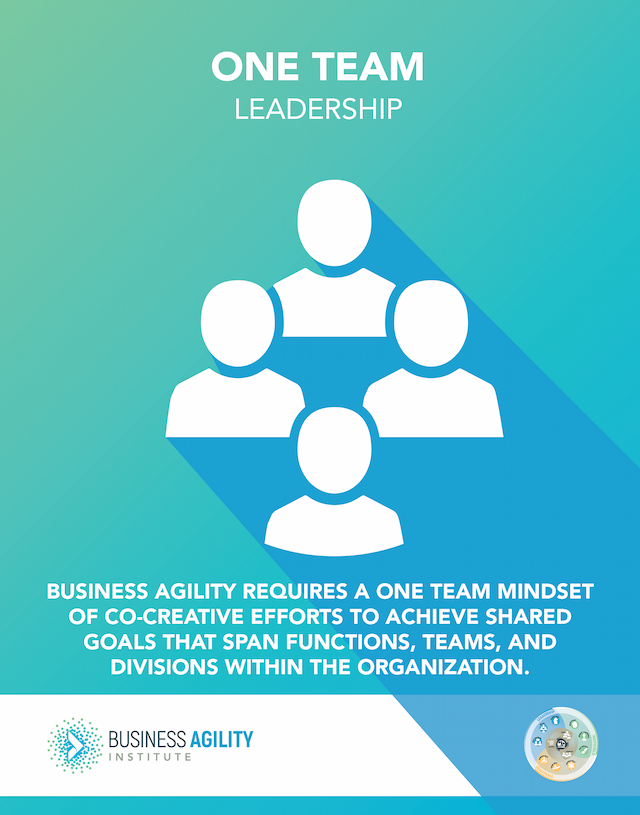Domains of Business Agility
- Customer
- / Customer
- Leadership
- / People Management
- / One Team
- / Strategic Agility
- Individuals
- / Growth Mindset
- / Craft Excellence
- / Ownership & Accountability
- Operations
- / Structural Agility
- / Process Agility
- / Enterprise Agility

One Team
01 Introduction
Business Agility requires a One Team mindset of co-creative efforts to achieve shared goals that span functions, teams, and divisions within the organization.
An agile organization is one that is designed to collaborate. The very construct of the organization – from the organizational structure, to the work processes, and even the way the market is engaged – promotes a sense of the organization as one team.
The complexity of collaboration is one of the fundamental reasons to keep teams in an agile organization small. O(n2) to be precise. 7±2 is a commonly accepted size. It’s helpful to localize decision-making in order to reduce the lines of communication, thus reducing any subsequent delays. However, don’t let the goal of collaboration impact your ability to be productive. Sitting in meetings and talking is not necessarily collaboration, whereas sitting quietly in a room by yourself can be.
Critical to effective collaboration is the default transparency of information, decisions, and relationships to provide a solid grounding for trust & respect between customers, peers, and leaders. All individuals have the ability to know what is going on so that they can make appropriate decisions. This doesn’t mean that everyone knows everything, rather that everyone has the choice of knowing anything. And, of course, the ability to be selectively opaque to the competition while being transparent internally is the real art of One Team.
There are many tools and practices that you can adopt to improve how your teams collaborate. For example, social contracts, pair programming (or pair work outside IT), and visualization tools (like Kanban Boards, Burndown Charts or Cumulative Flow Diagrams).
02 Moving from Theory to Practice
Your goal is to create a one team mentality that overrides divisional allegiance.
Communicate the Greater Purpose
Beyond your organization’s vision, people need to buy-in to the greater purpose of your organization. What value does your business bring to the community? What is your employee’s place in society and is it something they can be proud of? If people can identify the purpose in what they do, they are more likely to rally around their colleagues and the work to achieve a common outcome.
Charter the Team
All the practices and techniques described here give groups of individuals the opportunity to form a team. But, it is not automatic. When formed, teams need the opportunity to define common goals and ways of working through a team charter. The charter clearly and publicly articulates the direction of the team as well as its membership and scope, rules of operation, and agreed boundaries. Through this process, the team can start to develop a culture of honor and mutual respect.
Gain Buy-In
Keep teams small, eliminate politics, build a culture of “disagree but commit”, and develop a sense of accountability. These are the ways in which you develop heartfelt buy-in from individuals as they form a team. To gain buy-in from outside your team, show value through small experiments that deliver tangible results. It is also important to share new learning and insights from your successes and failures.
03 Measuring your Business Agility Maturity
Crawl
Walk
Run
Fly
Transparency & Sharing
Relevant information is available to anyone who requires it, yet the process to gain access is cumbersome and bureaucratic.
All individuals have access to key information & strategic decisions so that they can make appropriate decisions.
We have systems to promote transparency and information sharing across all levels of our organization. People have the ability to pull any relevant information they need to make decisions or deliver value.
The organization operates with a culture of transparency for all non-confidential information. This includes decisions, decision rationale, business strategy, business metrics, work status, and (with employee agreement) salary information.
Unity of Purpose
Leaders focus on their own silo, but will actively share information to help other teams.
Leaders no longer focus on their own silo, but on the whole organization. They are expected (and willing) to provide help to any team.
Leaders attempt to operate as one team. Yet, business systems and structures (e.g. business measures) are not fully aligned.
The executives of the company actively design systems & structures to ensure that they operate as one team (e.g. with common goals) towards the target customer experience.

